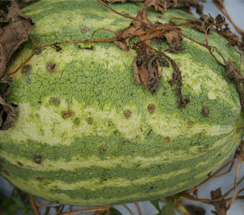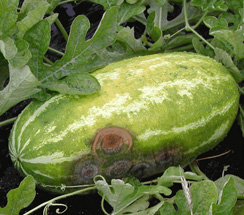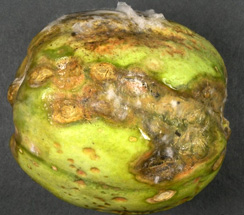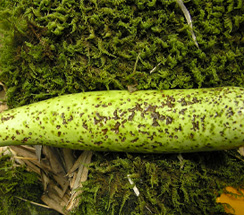Post Harvest Diseases:: Vegetables:: Cucurbits
| Anthracnose: Colletotrichum lagenarium |
Symptom:
- Older leaves show small, water-soaked or yellowish areas that enlarge rapidly and turn tan to reddish brown
- Spots - often circular to angular
- Later, spots may merge, blighting large sections of the leaf
- Petioles and stems - Tan to black, elongated and form slightly sunken streaks called cankers
- Attacks Watermelon, Cantaloupe, Cucumber
- Squash and pumpkin are almost immune
- Immature fruit - turn black, shrivel, and die
- Round, water-soaked spots develop on the older fruit
- Spots turn dark green to brown with age and may become sunken
- Under wet conditions, pinkish-colored spore masses can be seen oozing out of the sunken spots
|
 |
 |
 |
 |
| Water soaked spots on watermelon |
Concentric rings |
White mycelium on watermelon |
Water soaked spots on biottlegourd |
|
Identification of pathogen:
- Mycelium - septate, hyaline when young and dark when old
- Setae - brown, thick walled, 2-3 septate
- Conidia - hyaline, oblong and single celled
Mode of spread and survival:
- Soil and seed borne
- Fungus overwinters in old cucurbit vines or in weeds for 5 yrs
- Anthracnose can appear anytime during the season, but most damage occurs late in the season after the fruit is set
- Spread - running water, workers and the insect Pimelia sp.
Epidemiology:
- Warm, wet conditions - favour rapid development and spread of the disease
- Temp - 25°C, 100%RH
|
Management:
- Field sanitation - destroy the plant debris
- Hot water treatment of seeds @ 57.2°C for 20 min
- Seed treatment - thiram or carbendazim or mancozeb @ 2g/kg
- Spraying at weekly intervals of Carbendazim 0.1 %, Mancozeb 0.2%, Difolaton 0.2%
- Fruit dip - 5 min in wash water containing 120 ppm of chlorine helps to prevent infection of healthy fruits
- Resistant varieties in watermelon - Black Stone, Congo, Diamond, Charleston
|
Source of Images:
http://imgkid.com/anthracnose-of-cucurbits.html |
|




